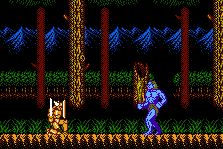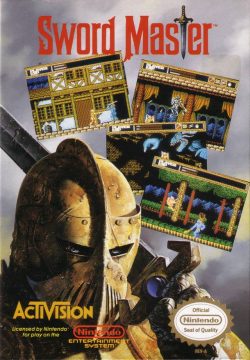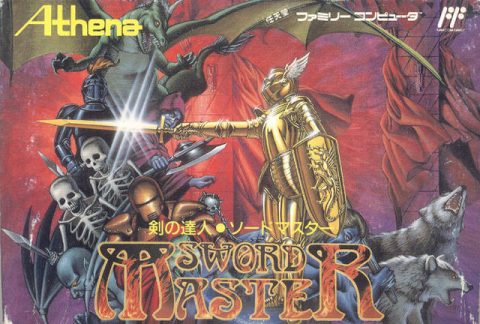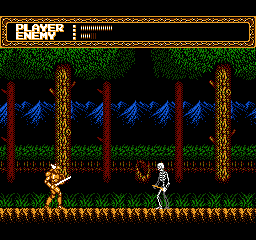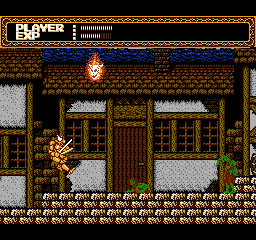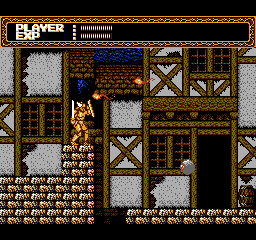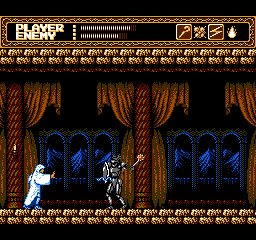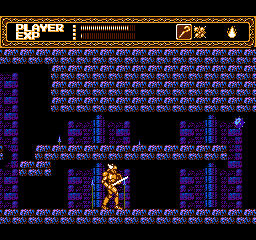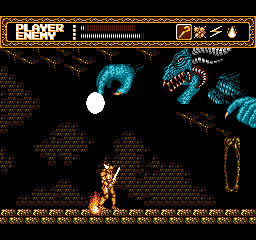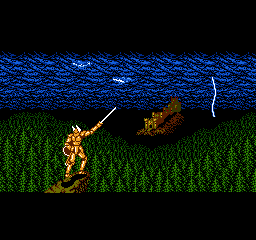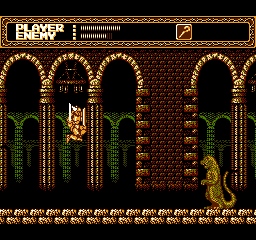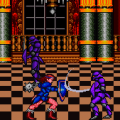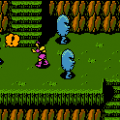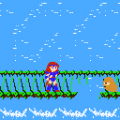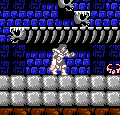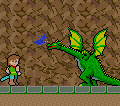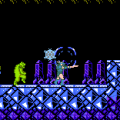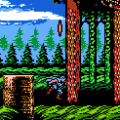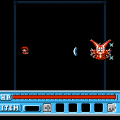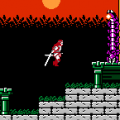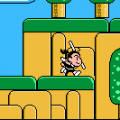- Castle of Dragon
- Sword Master
Many developers clamored to release games on the ailing NES when they knew that the next generation was coming in the form of the Genesis and the SNES. Athena, obscure though they were, also partook in releasing an 8-bit title in the nineties with Sword Master. This game appears somewhat akin to Castlevania and its contemporaries at first glance but turns out to put fighting over jumping as the chief modicum of action. It is also a spiritual successor to Castle of Dragon (moreso the NES port than the arcade original), as it features a similar setting, protagonist, enemies, and general gameplay. Though whereas Castle of Dragon was not very good, Sword Master is a more respectable product and is quite fun, if not rough around the edges.
Sword Master‘s plot is about as standard as you can get, and can actually be summed up in one sentence: A princess is kidnapped while a nefarious mage resurrects Vishok, the evil serpent god, and you are sent in to rescue her and foil the dastardly wizard. This is the sort of plot that’s been around since whenever mankind learned how to write stories, but that’s obviously what this game is not about. It also has a pretty stereotypical fantasy setting, albeit a dark one with some considerably well-done visuals. Right as you open up the game, the logo blazes with a neat fire effect within the back layer of the letters, and if you wait long enough, it launches into a neat textless intro that depicts all of the scary crap happening across the land.
In action, the game looks pretty dang good. Your protagonist, a knight in shining golden armor, is reasonably well-animated as he saunters along at a decent clip, almost with a Belmont-esque sort of gait. The sprites are of a decent size and are quite detailed, often toned in one or two colors that are often dark and subtle. In fact, the backgrounds are all quite dark to boot, but not in the “I can’t see anything” sort of way. It’s more the “gritty and gloomy” sort of dark that makes the backgrounds feel clad in a perpetual darkness, and it lends to Sword Master a unique feel that looks badass without belaboring it. It’s nothing you haven’t seen in any other Middle Ages tale, what with forests and run-down towns and castles and so forth, but it gets style points for keeping the vibe grim with colors on the opposite polar end of other fantasy fare like Dragon Quest and characters not as cartoony as Wizards and Warriors. It also features some good music that sounds as if it were composed for a lost Castlevania game, with the tracks for the first, fourth, and seventh levels serving as high-energy standouts which really get you geared for slaying some monster butt. The third level track is kind of middling, and not much of the music is insanely catchy, but it makes fine use of the NES’s later sound capabilities.
As you may expect from the title, you are a Sword Master whose blade is your best friend and your shield as your second-best. Your goal is to hack and slash your way through any and all adversaries that may stand in your path. You’re able to deliver standing and crouching stabs, as well as a useful overhead slash by holding up while attacking. You’re also able to defend against frontward attacks by crouching and aerial attacks by holding up, though jumping away is sometimes preferable to defending against attacks. Your jump moves quick and drops fast, as opposed to most 2D jumps which come off as a bit floaty, but there is not too much platforming in SM for the most part.
Nope, the focal point of Sword Master is the incredibly high amount of boss fights, of which most stages have about three major fights on average. Only a few steps into the first area, you are accosted by a skeleton with a sword of his own, and he knows how to swing AND block. Just right past him is a tall blue ogre whose club swings hurt, even though he’s arguably easier than the skeleton due to being slow and unable to block. Too bad there’s another skeleton right after him, and right past him is a blue wizard who can rain down dark fire and warp around a la Dracula. They only get more malevolent from then on outward, like the black knight at the end of the second level who’s a terribly smart fighter and can really only be beaten by jumping in with overhead strikes and jumping back out before he can hit you.
With other such neat fights as jump-kicking lizardmen, flying gargoyles that bombard you with blue fireballs, and the obligatory battles against bipedal fire-spouting dragons, one may wonder why they didn’t just cut out all the fodder and pitfalls and just get to the duels. It does indeed have other enemies like bats and zombie torsos, but they’re often extinguished in a single strike. One of the very few games to which Sword Master can be compared is Taito’s Gladiator, which is essentially the same premise by tossing filler enemies at you before bringing you to a boss battle in about thirty seconds’ time. Gladiator did not allow jumping and had your hero walk along at an automatic pace, and if you were struck on a body part where your armor was sheared off, that’s a life lost there. Sword Master at least gives you a proper lifebar and motivation to slay the enemies by giving you an experience bar, and if you fill it up with enough minion blood, your lifebar is extended for the rest of the game. They might also drop jars full of red stuff that boosts your life by a point, so it’s in your best interest to cut down as much as you can.
Despite being called Sword Master, you actually get an alternate form of attack that is considerably un-swordlike. After you beat the second stage endboss, you get a magical cane which then allows you to completely change form. With a push of the select button, you morph from your conventional gold armored knight into a white-robed mage, somewhat akin in appearance to Sypha from Castlevania III. At first, you can only fire a short-range projectile that is weaker and slower than your default sword swings, but beating other levels gives you the ability to shoot fireballs, exploding arc shots, and electric bolts that do considerable damage to adversaries. Considering how you don’t have to get close with these extra powers, it sounds like magic would be the way to go for the rest of the game. Sadly, using any other magic attack besides the default drains a bit from your experience bar each time you cast them, so you really have to consider the risk of better attack power weighed against a lesser lifebar.
So why isn’t Sword Master a better remembered game than the relative obscurity into which it is cast? It’s a fast-paced action game that offers much variety in its boss battles, and it looks and sounds good enough to stand alongside most other nineties NES games. No one knows just why it was ignored at release and beyond, but it might have to do with the fact that it’s really freaking difficult, and admittedly a bit unfair at times. It’s not always easy to evade or block enemy attacks, some of which do quite a bit of damage if they strike. That being said, the fights can be won with enough practice and a bit of luck, but on one of the stages, some strange designer thought it would be ideal to focus on platforming for a change and put in an abnormally high amount of instant death falls. Level four is arguably the worst part of the game, as it is rife with horrid pitfalls with indestructible eyeballs floating up and down above them, just waiting to knock you over with just the slightest graze. This game is clearly not designed for platforming considering how much gravity your jumps contain, and at several points, you have to exploit a bizarre glitch where you can double-jump if you fall onto the edge of a platform, and for a few such jumps, there is literally no other way to climb onto platforms.
If only double-jumps were something you could do normally, or at least if your jump had a bit more height to it, stage four wouldn’t be so horrible. Perhaps it would have been preferable if the level didn’t even have any pits in it at all, but aside from the sixth stage, nearly every other level is simply a straight line from left to right. The sixth level tosses a bunch of spears, spiked balls, and falling blocks at you along with a few pits, with the only enemies being slimes and the giant axe-guy at the end. That part feels a bit less aggravating compared to the fourth level, if only just because they don’t do too much damage despite being hard to avoid. Stage four is the worst it gets for unfairness, but the last stage, despite being a straight-up brawlfest, is ruthless with about half-a-dozen bosses back-to-back, expecting you to beat most of them on one lifebar. The bloody wizard at the end of this gauntlet has a lightning attack which is basically impossible to avoid and forces you to kill him ASAP, but your life is likely low at this point and getting slain sends you back to the beginning of the level. The game mercifully gives you a checkpoint before the (surprisingly easy) penultimate boss and the finale against Vishok, the latter of which comes down to a frustrating fight of attrition that essentially requires you to just be faster than you are skilled.
The challenge is hence a bit steep to say the least. The topper to all this is that you’re only given five continues to last you for the entire run of it. Somewhat counterbalancing this meager ration is the compounded length, wherein you can actually beat the game in less than half an hour if you’re diligent enough. Sword Master is thus the sort of game that relies on the three P’s of practice, patience, and perseverance. It may not exactly be a ringing classic, mostly due to its considerable shortness weighed against its punishing difficulty and the lack of any sort of passwords to maintain your progress hence. It is as “old-school” as an action game can get, and considering that it was released late during the NES’s lifespan, it went under most everyone’s radar.
Activision published the U.S. version, curiously enough, and they had long since fallen out of favor after their heyday during the Atari years, having been relegated to publishers for notorious crap like Ghostbusters, Super Pitfall, and Predator. Sword Master just may be the finest game they released for the gray box, yet it got no advertising budget save for a fairly detailed expose in volume #23 of Nintendo Power. It could have used more attention than it deserved, as despite its difficulty and the horrid programming of stage four, it’s actually a fine and fast action game for those willing to put up with its viciousness. Sword Master may not be for everyone, it certainly deserves a play for retro action junkies who want to play something primarily focused on medieval combat and are willing to deal with the occasional fiddly bit of rocky platform jumping.
